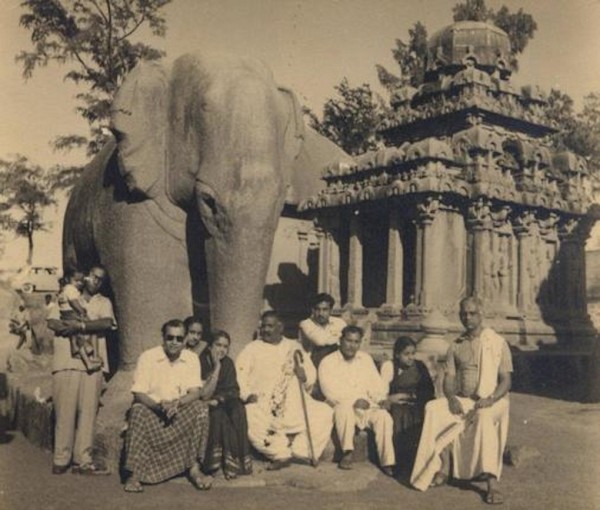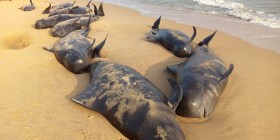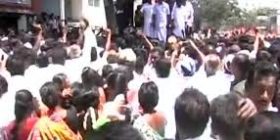Tamil Nadu is full of ancient heritage sites. If you are a student of history, art, ancient culture and anthropology, any number of trips will not satisfy your curiosity. This time around I took a trip to the nearest one on the outskirts of the city. Mahabalipuram is just a drive away and an ideal weekend getaway. If you are interested in ancient Tamil history, art and culture, it is a bonus. Seventh century in Tamil Nadu was a rather busy era. The Bhakthi Movement was at its peak with the Alwar saints. The Pallava kings who ruled along the seashore, with Kanchipuram as their capital, were great patrons of art, music, dance, religious studies and trade. Rajasimha (690 -728) was a fine poet and lover of architecture and sculpture. He was honoured with the title of ‘Kala Samudra’ or ‘Ocean of Arts’. His love for poetry, music, dance and arts is manifest in the little town of Mahabalipuram. There are three prevalent stories about the name.
The ancient name of this town was ‘Mahamallapuram’. ‘Mallal’ in ancient Tamil meant prosperity. The town was closely connected to the capital of Kanchi. Kanchipuram was the most important city in the northern part of Tamil Nadu for over two thousand years up to the seventeenth century. As a center of trade and culture, it thrived with wealthy patrons and a vibrant economy. Another story goes that Mamallapuram might have been established as a port by Narasimha –I after his title ‘Mamalla’ or the ‘great warrior’.
There is no clear evidence for this association. However, you can find the same title bestowed upon his son Rajasimha. He was popular among his subjects as ‘Mamalla’. An inscription found in the village of Vayalur describes him as ‘Vidita Mahamalla Sabdah Prajanam’. You can find scores of inscriptions across places like Kanchipuram, Vayalur, Panamalai, Dalavanur, Thirupporur and Thirukkulakundram. What is fascinating to see even till today is Rajasimha’s taste for language and grammatical acrobatics. From the simple Pallava Grantha script to to a more ornate one where calligraphic letters resemble animals and birds to a further more ornate Nagari script, Rajasimha enjoyed playing around. He employed the finest of master sculptors to do this job. A sample of his indulgence can be found in Kanchipuram, where he arranged over three hundred of his titles in alphabetical order. If you read closely you will find each title written in four different scripts! With rulers like him, Mamallapuram’s citizens must have lead richly artistic lives.
Around the middle of fifth and sixth centuries, the Vaishnavite saint Bhutattalwar was born in Mamallapuram. The other version about this name goes back to the mythology of Vishnu’s Vamana incarnation and the story of emperor Bali. I don’t have to go into the history of the place and what all is present now. Enough and more has been written about it.
Here I write my own experience of the place with a personal guide Anand who decided to volunteer and walk me around the ruins. Anand has been a tour guide for four decades now. While his enthusiasm was worth appreciating, his own knowledge of the place was rather sketchy. We headed to the shore temple where I spent a whole day.
Legend goes that this was a collection of seven pagodas, scattered across the area. Only one exists now. “The other six are under the ocean!” exclaimed Anand, without telling me anything more about the dates or historical evidence. When I questioned him further, he said “the gods of the ocean were jealous that humans are having all temples and so decided to swallow six of them and leave one for us!” I found this explanation amusing.
The shore temple, built by Rajasimha, is dedicated to Shiva in the form of ‘Somaskanda’. The complex consists of three temples. Sandwiched between two Shiva temples is a Vishnu temple where you can see Vishnu as ‘Anantashayana’. An inscription found on the lintel says ‘Narapatisimha Pallava Vishnu Griha’. ‘Narapatisimha’ was one of the many titles of Rajasimha. In this Vishnu temple it is unique to find that he is not resting under the usual Adi Shesha’s hood. This is one of the six important places dedicaded to Vishnu as ‘Anantashayana’. The other five are Srirangam and Kanchipuram, Srirangapatnam near Mysore, Thiruvananthapuram in Kerala, Tirupati in Andhra. The sidewalls of this Vishnu temple have sculptures of Krishna leelas. One is Krishna felling the demon Kesi in horse form and Krishna dancing on the snake Kaliya and the other is that of Gajendra Moksham.
Shiva as Somaskanda
Inside the main east-facing temple, behind a broken Shiva Lingam on the wall was a large Somaskanda. The temple was worshipped for several hundreds of years before it was invaded by Pulakesi II, the Chalukyan ruler and desecrated. In temple-run economies, it was common for the invader to desecrate the temple to destabilize the kingdom. The Shiva Lingam inside is tall and has sixteen faces. In the main entrance of the temple is a wonderful sculpture of Ekapadamurti. “This is G-O-D!” exclaimed Anand. “G for Generator, O for Operator and D for destroyer!” he added.
Ekapadamurti in the entrance
The Ekapadamurti depicts the holy trinity of Brahma-Vishnu-Shiva, as one. The sculpture has three heads, one body and one leg. I was engrossed in enjoying the beauty of this sculpture and amused at how Anand managed to define it. In the temple complex are also three Bali Peethas or temple altars where animal sacrifice was once practiced. In today’s times when everything about temples and Hindu worship has gained a puritanical definition, it was important to see how an ancient practice was. The Balipeethas have inscriptions in Sanskrit written in Pallava Grantha extolling the virtues of Rajasimha and his many sacrifices.
Two inscriptions of Rajaraja Chola I dated 1010 CE, when he was twenty five, can be seen under the smaller Shiva temple. These inscriptions mention the names of all the three temples as ‘Kshatriyasimha Pallaveshwara Griham – Rajasimha Pallaveshwara Griham – Pallikondaruliya Devar’. They state how the rock-cut Vishnu temple was the first to be erected before the other two structures came up. More information from these inscriptions is that there were flower gardens on either side of the complex and these temples were highly sought after and worshipped in the 11th century. Beside the main temple is a small tank-like structure. In the middle of this tank is a miniature temple, circular in plan and elevation. It has a small socket in the center in which you can see a sculpture of Shiva as ‘Tripurantaka’.
Tank with miniature temple and Varaha statue
If you study closely, the base of this miniature temple is a square with octagonal and circular paths one above the other, closely resembeling a Yantra. This depicts how sculptors of that era were not just masters of Shilpa Sastra, Aagama Sastra and Vastu Sastra, but also educated in Yantras, Mantras and Tantras, in addition to music, dance and so forth. Education was highly interdisciplinary in nature and there was no compromise about any knowledge forms consumed. In the middle of this little tank, beside the miniature temple is one of the finest sculptures of a rock cut boar representing Varaha incarnation of Vishnu. What is fascinating about this Varaha is that unlike anywhere else in India, here you find the boar ready to dive into the ocean with its head down and pressing its hind legs with great force.
Anand told me how the boar gets submerged during the rainy season or even during high tide and it is a spectacle worth viewing. To the south of the main temple is a large rock cut lion. A carved socket in its heart serves as the sanctum, within which is a carving of Mahishasura Mardini. The Upanishadic concept that likens the heart to a cave is reinforced here. Below the big lion is a beautifully carved headless deer, as if to suggest a Bali or a sacrifice to the goddess. I have not come across another sculpture portraying death this beautifully.
Vishnu as Anatashayana
Mamallapuram has inspired scores of visitors down the centuries. Even the famous poet saint Chaitanya Mahaprabhu from Bengal visited this place between 1510 and 1512. I remembered the famous story of how the great Hindustani vocalist Ustad Bade Ghulam Ali Khan visited this temple on a picnic with his Carnatic musician friends G N Balasubramaniam and Veena Balachander. Inspired and moved by the sculptures at the shore temple, the Ustad took out his Swarmandal and launched into a series of Bhajans in praise of Shiva, Vishnu and the goddess. This only proves that great places of art continue to inspire true artistes irrespective of the narrow boundaries of religion, caste or age.
I was back in Mamallapuram after over a decade. With much hesitation, I stayed at a government accommodation on the seashore. The manager told me how the entire place was submerged during the catastrophic tsunami in 2004. Going by his version, I must confess how impressed I was with the place and arrangements. The Tamil Nadu tourism development cooperation runs this space and has maintained it with great care. The place has the luxury of a private beach, which is spic and span. Observing a sunrise and sunset on this beach as I sat down to make my notes watching the waves was an experience I will remember for a long time. The accommodation here is far more pocket-friendly than most of the other private properties around the place, who are busy minting money at the expense of innocent tourists. For many like me who are not ready to trust a State initiative blindly at face value, this place was a revelation and a wonderful surprise. The shore temple is maintained in an excellent condition. No plastic, littering and garbage like you find elsewhere at heritage structures in several other parts of India. No scribbling on the walls and defacing monuments. I stayed for a weekend in Mamallapuram and visited all the monuments, studied them meticulously with a different perspective and point of view from my last visit. Each of them deserves to be written about separately and not condensed into one piece. For now, pack your bags and head to the shore temple. A whole day is still not enough to enjoy this magnificent place!






Leave a reply